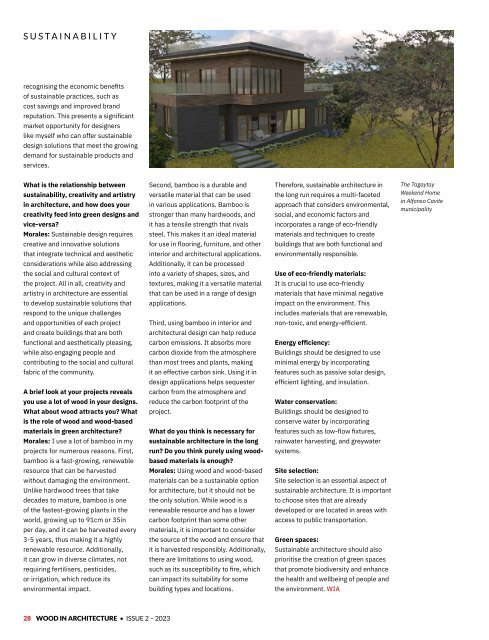WIA_ISSUE2_2023
Create successful ePaper yourself
Turn your PDF publications into a flip-book with our unique Google optimized e-Paper software.
SUSTAINABILITY<br />
recognising the economic benefits<br />
of sustainable practices, such as<br />
cost savings and improved brand<br />
reputation. This presents a significant<br />
market opportunity for designers<br />
like myself who can offer sustainable<br />
design solutions that meet the growing<br />
demand for sustainable products and<br />
services.<br />
What is the relationship between<br />
sustainability, creativity and artistry<br />
in architecture, and how does your<br />
creativity feed into green designs and<br />
vice-versa?<br />
Morales: Sustainable design requires<br />
creative and innovative solutions<br />
that integrate technical and aesthetic<br />
considerations while also addressing<br />
the social and cultural context of<br />
the project. All in all, creativity and<br />
artistry in architecture are essential<br />
to develop sustainable solutions that<br />
respond to the unique challenges<br />
and opportunities of each project<br />
and create buildings that are both<br />
functional and aesthetically pleasing,<br />
while also engaging people and<br />
contributing to the social and cultural<br />
fabric of the community.<br />
A brief look at your projects reveals<br />
you use a lot of wood in your designs.<br />
What about wood attracts you? What<br />
is the role of wood and wood-based<br />
materials in green architecture?<br />
Morales: I use a lot of bamboo in my<br />
projects for numerous reasons. First,<br />
bamboo is a fast-growing, renewable<br />
resource that can be harvested<br />
without damaging the environment.<br />
Unlike hardwood trees that take<br />
decades to mature, bamboo is one<br />
of the fastest-growing plants in the<br />
world, growing up to 91cm or 35in<br />
per day, and it can be harvested every<br />
3-5 years, thus making it a highly<br />
renewable resource. Additionally,<br />
it can grow in diverse climates, not<br />
requiring fertilisers, pesticides,<br />
or irrigation, which reduce its<br />
environmental impact.<br />
Second, bamboo is a durable and<br />
versatile material that can be used<br />
in various applications. Bamboo is<br />
stronger than many hardwoods, and<br />
it has a tensile strength that rivals<br />
steel. This makes it an ideal material<br />
for use in flooring, furniture, and other<br />
interior and architectural applications.<br />
Additionally, it can be processed<br />
into a variety of shapes, sizes, and<br />
textures, making it a versatile material<br />
that can be used in a range of design<br />
applications.<br />
Third, using bamboo in interior and<br />
architectural design can help reduce<br />
carbon emissions. It absorbs more<br />
carbon dioxide from the atmosphere<br />
than most trees and plants, making<br />
it an effective carbon sink. Using it in<br />
design applications helps sequester<br />
carbon from the atmosphere and<br />
reduce the carbon footprint of the<br />
project.<br />
What do you think is necessary for<br />
sustainable architecture in the long<br />
run? Do you think purely using woodbased<br />
materials is enough?<br />
Morales: Using wood and wood-based<br />
materials can be a sustainable option<br />
for architecture, but it should not be<br />
the only solution. While wood is a<br />
renewable resource and has a lower<br />
carbon footprint than some other<br />
materials, it is important to consider<br />
the source of the wood and ensure that<br />
it is harvested responsibly. Additionally,<br />
there are limitations to using wood,<br />
such as its susceptibility to fire, which<br />
can impact its suitability for some<br />
building types and locations.<br />
Therefore, sustainable architecture in<br />
the long run requires a multi-faceted<br />
approach that considers environmental,<br />
social, and economic factors and<br />
incorporates a range of eco-friendly<br />
materials and techniques to create<br />
buildings that are both functional and<br />
environmentally responsible.<br />
Use of eco-friendly materials:<br />
It is crucial to use eco-friendly<br />
materials that have minimal negative<br />
impact on the environment. This<br />
includes materials that are renewable,<br />
non-toxic, and energy-efficient.<br />
Energy efficiency:<br />
Buildings should be designed to use<br />
minimal energy by incorporating<br />
features such as passive solar design,<br />
efficient lighting, and insulation.<br />
Water conservation:<br />
Buildings should be designed to<br />
conserve water by incorporating<br />
features such as low-flow fixtures,<br />
rainwater harvesting, and greywater<br />
systems.<br />
Site selection:<br />
Site selection is an essential aspect of<br />
sustainable architecture. It is important<br />
to choose sites that are already<br />
developed or are located in areas with<br />
access to public transportation.<br />
Green spaces:<br />
Sustainable architecture should also<br />
prioritise the creation of green spaces<br />
that promote biodiversity and enhance<br />
the health and wellbeing of people and<br />
the environment. <strong>WIA</strong><br />
The Tagaytay<br />
Weekend Home<br />
in Alfonso Cavite<br />
municipality<br />
28 WOOD IN ARCHITECTURE • ISSUE 2 – <strong>2023</strong>

















